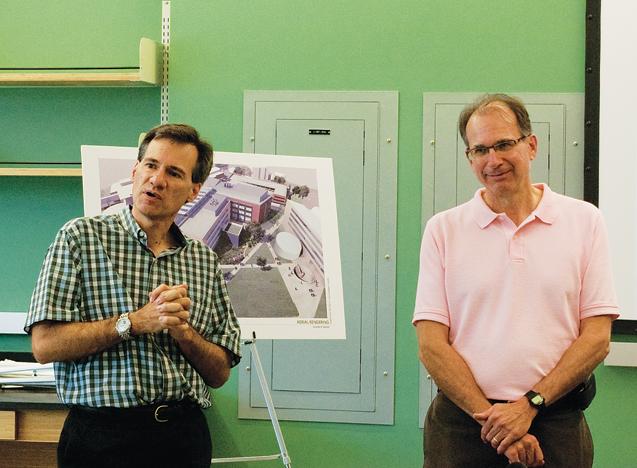Iowa State Biorenewables Research Lab claims to have best campus view
September 15, 2010
The new Biorenewables Research Laboratory claims to have the best view on campus.
Located between the College of Design and Howe Hall, this four-story “green” building houses the Bioeconomy Institute, directed by Robert Brown, distinguished professor of mechanical engineering.
“Biorenewables is the conversion of plant materials, crops, even microalgae into fuel and building materials,” Brown said.
Around 160 faculty are affiliated with the biorenewables program, representing virtually every college on campus.
“The main intent is that this is an interdisciplinary building,” said Brent Shanks, professor of chemical and biological engineering.
This collaborative effort shows up in the building’s architecture, artwork and design. The main lobby is filled with artwork representing the center’s biorenewable mentality. One piece, located in the administrative offices, was created using soy wax in place of beeswax, which is in rapid decline.
Currently there are 12 biorenewables graduate students and around 35 graduate students declaring biorenewables as their minor.
Maddi Sieck, program assistant at the bioeconomy institute, suggested students get their major in chemistry, chemical engineering or agronomy, with biorenewables supplementing their education.
Jackie Shanks, professor of chemical and biological engineering, is working on projects concerning medicinals and the direct replacement for fuel from algae and plants.
The fourth floor of the building was designed to be rotated among faculty as their research projects change. The setup makes communication between departments much easier than having to trek across campus.
“It’s so much faster,” she said. “I can already see a huge impact on our research.”
The interaction room on the fourth floor has fostered creativity and communication between students, faculty and staff.
“I think it’s the best view on campus,” Jackie Shanks said. “Sometimes we have visitors come over here for lunch because they love the view.”
The building was completely funded by a legislative appropriation of $32 million, a huge investment by the state in biorenewables.
“This usually requires fundraising but the state saw that this was so important that they made a full endorsement,” Brown said. “This gives us a huge responsibility.”
But the Biorenewables Complex is only halfway there. The second phase of construction will develop the agricultural and biosystems engineering building and atrium, which will be attached to the BRL.
In total, both phases will cost $107.1 million. The second phase will have to be funded regularly, through state funding, fundraising and private gifts.
Hiding behind one closed door on the third floor is, surprisingly, the smell of barbecue.
“We produce biofuel in here that smells like barbecue sauce,” Brown said. “The Iowa Department of Transportation was considering paving a bicycle path with this stuff.”
“This stuff” is bioasphalt, made from wood chips, switchgrass and cornstover.
“I think they should pave Hickory Park’s parking lot with bioasphalt,” Brown said, joking. “It would double their revenue.”
Biorenewables will host a symposium next week, bringing scientists and engineers from around the world to discuss thermal and catalytic sciences for biofuels and biobased products.
“It was scheduled to be at Scheman but after the floods it will be held in C.Y. Stephens Auditorium, Fischer Theater and a big tent in the courtyard,” said Jill Euken, program director for the bioeconomy institute. “We’re calling it the ‘TCS Plaza.'”
The BRL has been nominated for gold LEED certification, Sieck said. “Green” aspects of the building include:
– South-facing windows give 92 percent of the building direct sunlight
– Rain water recovery and reuse
– 93 percent of the building’s waste is recycled
– 30 percent of the building’s materials are renewable
– The building was made of local materials (within a 500-mile radius)
– Partially vegetated roof
– Soon to come: native prairie grasses that don’t require watering
Upcoming Events:
Formal Dedication – 3 p.m. Friday, Sept. 17
Staff will light a blow torch to a carbon chain, acting as a ribbon cutting.
Symposium on Thermal and Catalytic Sciences for Biofuels and Biobased Products on Sept. 21 to 23 in tents outside Scheman Building.

















